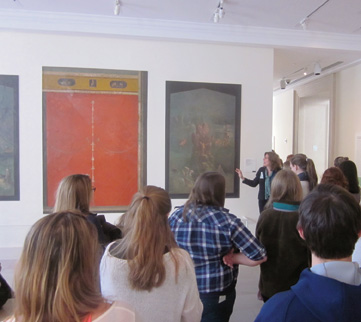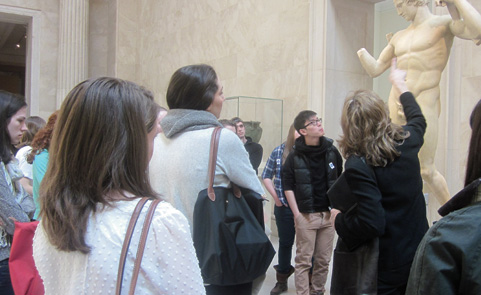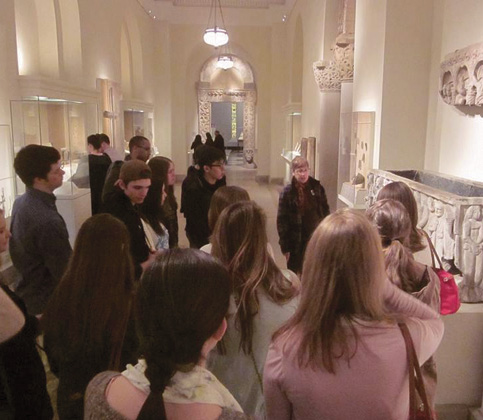An alumnus supports arts field trips to New York City
by Jim H. Smith
On a Sunday afternoon last October, the Brooklyn Academy of Music’s (BAM) immense Howard Gilman Opera House was packed to the rafters. The sellout crowd was there for the much-anticipated performance of “…como el musguito…,” the final work of the celebrated German choreographer Philippina “Pina” Bausch, who died in 2009. As with many of Bausch’s works, the musical motifs, visual media, and breathtaking sets (including a moving floor) created a remarkable spatial landscape upon which the members of her dance company—Tanztheater Wuppertal—were testifying to her genius.
Nearly every eye in the house was locked on the stage. But Associate Professor of Theater and Dance Katharine Power, contemplating the fact that New York is one of the few places in the world where a 2,000-seat venue could attract enough dance enthusiasts to fill every seat, turned her attention, for a few moments, on the group of students with whom she had traveled from Trinity earlier in the day. Power directs the Interarts program, Trinity’s multidisciplinary, first-year class that affords a small group of outstanding students an
opportunity to explore the role of art and artists in society. The students were, she observed, watching the dancers with unusual intensity. Some of them, notes Professor Mitchell Polin, who also attended the program with many of his theater and dance students, were practically gape-jawed at what they saw. “It’s a great example of why field trips like this are so important,” says Polin. “Without them, many of our students would never have a cultural opportunity of this sort.”
A number of them, indeed, were visiting not only BAM, but New York City for the first time. “It was doubly valuable to be able to expose them to both the work of such an important artist as Pina Bausch and the enthusiasm that motivated such a large audience to attend the performance,” says Power. Within weeks of the BAM excursion, another Trinity group traveled to New York City to see the acclaimed Picasso Black and White exhibit at the Guggenheim Museum. They were accompanied by Professor of Fine Arts Michael Fitzgerald, an internationally recognized Picasso authority.
Trinity is close enough to New York to make such field trips logistically feasible. In the past,
however, transportation probably would have been provided by a caravan of automobiles, rather than the comfortable bus aboard which students and faculty made the trip last fall. And, notes Polin, students might have been obliged to chip in for the expenses, including tickets, a hardship for those on financial aid. Now, thanks to a gift by a grateful alumnus, more Trinity students can expect to visit New York’s museums and cultural venues for experiences that will significantly enrich their education.
Access to arts: The Fleischman Fund
 When Illinois native Aaron Fleischman enrolled at Trinity in the autumn of 1956, he was the personification of an eager liberal arts student. “I wanted to come to New England,” he recalls. “And I wanted a good education from a highly regarded liberal arts college.”
When Illinois native Aaron Fleischman enrolled at Trinity in the autumn of 1956, he was the personification of an eager liberal arts student. “I wanted to come to New England,” he recalls. “And I wanted a good education from a highly regarded liberal arts college.”
An English major, who was “very interested in history,” Fleischman found himself immersed in classes with professors he liked, who challenged him intellectually. When he graduated in 1960, it was with honors, Phi Beta Kappa and Pi Gamma Mu. He would eventually settle on a career in law, after earning his law degree from Harvard Law School. For 35 years Fleischman headed his own firm, and since 2011 he has been a partner with Edwards, Wildman and Palmer, a large international firm, into which he merged his firm in 2011.
“I feel fortunate to have had a very successful career,” he says. And as the 50th anniversary of his graduation from Trinity neared, he was moved to acknowledge the important role his undergraduate liberal arts experience played.
“I’m personally interested in the arts and cultural activities,” he says, “and I realized that Trinity has an important advantage over many colleges and universities because of its proximity to New York.” So in 2010 he established the Aaron I. Fleischman ’60 Fund for the Study of Arts, Culture, History, and Literature. The fund’s purpose is to “enrich the educational experiences for students studying English, fine arts, history, and American studies, by providing funding to those courses to access arts, culture, history, and literary experiences in New York City.”
Reacting to art
The fund had an almost immediate impact. Professors in several of the disciplines covered by Fleischman’s fund began scheduling trips to New York.
 Associate Professor of Fine Arts Kristin Triff has taken two groups of students to the city in the past year, most recently to visit The Metropolitan Museum of Art. “Most students have never been to the Met before,” she says. “The experience often becomes a huge piece of their liberal arts experience. “It’s fantastic to watch them reacting to art that they’ve previously seen only in books or documentary films. There’s no classroom experience that can approximate what it’s like to view art firsthand, and without generous support from alumni like Mr. Fleischman, experiences like this would be, at the very least, much more
Associate Professor of Fine Arts Kristin Triff has taken two groups of students to the city in the past year, most recently to visit The Metropolitan Museum of Art. “Most students have never been to the Met before,” she says. “The experience often becomes a huge piece of their liberal arts experience. “It’s fantastic to watch them reacting to art that they’ve previously seen only in books or documentary films. There’s no classroom experience that can approximate what it’s like to view art firsthand, and without generous support from alumni like Mr. Fleischman, experiences like this would be, at the very least, much more
challenging to produce.”
Nicole Schwartz, a sophomore art history and urban studies major, has traveled to New York on field trips three times since coming to Trinity. When she visited the Frick Collection last year with Alden Gordon, Paul E. Raether Distinguished Professor of Fine Arts, the experience was significantly enhanced by the fact that Gordon, in the late ’70s, was a
curatorial assistant at the Frick.
“Being able to participate in one of these excursions, travel on a bus with knowledgeable professors, and have the entire thing planned, makes it an experience many students can enjoy, regardless of their means,” she says.
“I’m very pleased with the feedback I’ve gotten,” says Fleischman. “I’m glad I can help make that possible. When you attend Trinity, the College becomes a part of your life and texture. For a lot of students visiting New York, it’s not just the museums, but the
entire experience that can be terrific.”


